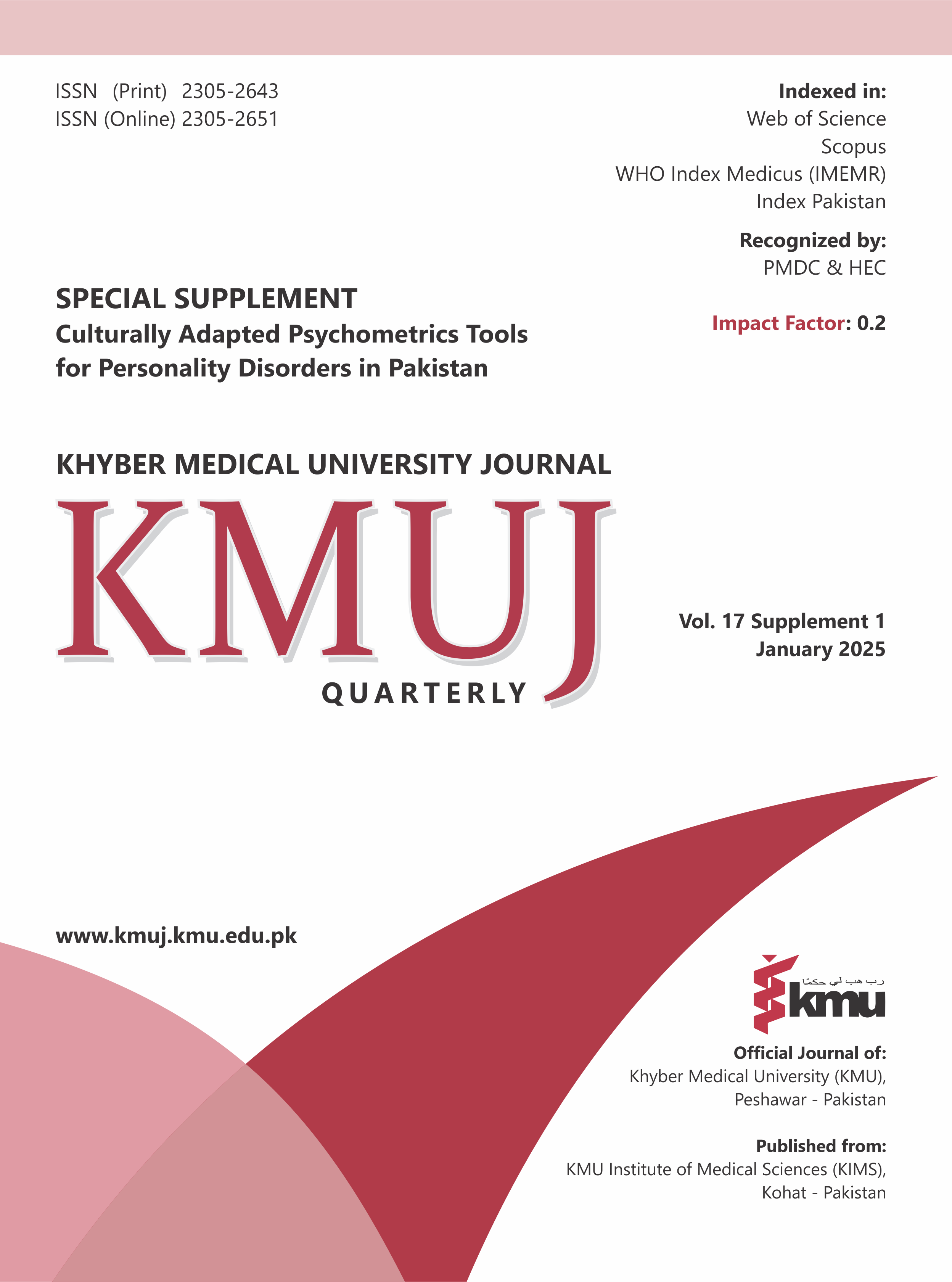Development and psychometric validation of an indigenous Urdu Histrionic personality disorder scale for adults
Main Article Content
Abstract
Objective: To develop and validate an indigenous Urdu scale for measuring Histrionic Personality Disorder (HPD) in adults, based on the diagnostic criteria outlined in DSM-5, and to assess its psychometric properties.
Methods: This cross-sectional analytical study, conducted from February 15 to June 20, 2019, was divided into two phases: scale development and verification of psychometric properties. In the development phase, a 59-item pool based on DSM diagnostic criteria was content-validated by experts and administered to 104 participants. Inter-item correlation analysis reduced the items to 41 with correlation ≥0.4. For final administration, responses from 234 adults (Males=124, Females=110) from clinical and non-clinical populations in Gujrat, Pakistan, were collected using the refined scale. Further analysis reduced the scale to 22 items, resulting in a concise measure.
Results: The initial 59-item Histrionic Personality Disorder Scale (HPDS) was refined to 22 items through Exploratory Factor Analyses (EFA) and Confirmatory Factor Analysis (CFA). EFA identified eight factors explaining 66.12% variance, while CFA confirmed seven factors with acceptable model fit indices (CFI=.941, GFI=.886, RMSEA=.056). The scale demonstrated excellent reliability (Cronbach’s α=.924) and subscale reliability ranging from .726 to .845. Convergent validity, assessed against the Brief Histrionic Personality Scale, showed a strong correlation (r=.741, p<.01). These findings establish HPDS as a psychometrically sound tool for measuring histrionic personality traits in clinical and non-clinical populations.
Conclusion: This study developed a 22-item Urdu HPDS for adults in Pakistan, demonstrating strong reliability, validity, and cultural relevance. It is a valuable tool for research, diagnosis, and clinical application across diverse settings.
Article Details

This work is licensed under a Creative Commons Attribution 4.0 International License.
Work published in KMUJ is licensed under a
Creative Commons Attribution 4.0 License
Authors are permitted and encouraged to post their work online (e.g., in institutional repositories or on their website) prior to and during the submission process, as it can lead to productive exchanges, as well as earlier and greater citation of published work.
(e.g., in institutional repositories or on their website) prior to and during the submission process, as it can lead to productive exchanges, as well as earlier and greater citation of published work.
References
1. Novais F, Araújo A, Godinho P. Historical roots of histrionic personality disorder. Front Psychol 2015;25(6):1463. https://doi.org/10.3389/fpsyg.2015.01463
2. American Psychiatric Association. Diagnostic and Statistical Manual of Mental Disorders. (4th ed. TR). American Psychiatric Association; Washington, DC, USA. 2000. ISBN: 978-0890420256.
3. American Psychiatric Association. Diagnostic Statistical Manual for Mental Disorders. (5th ed. TR). American Psychiatric Publications; Arlington, VA, USA. 2013. ISBN: 978-0890425763
4. Ferguson CJ, Negy C. Development of a brief screening questionnaire for histrionic personality symptoms. Pers Individ Dif 2014;66:124-7. https://doi.org/10.1016/j.paid.2014.02.029
5. Sperry L. Handbook of Diagnosis and Treatment of DSM-IV-TR Personality Disorders. 2nd ed. Bruner-Routledge; New York, USA. 2003. ISBN: 978-0415935692
6.Morrison J. Histrionic personality disorder in women with somatization disorder. Psychosomatics 1989;30(4):433-7. https://doi.org/10.1016/s0033-3182(89)72250-7
7. Cale EM, Lilienfeld SO. Histrionic personality disorder and antisocial personality disorder: sex-differentiated manifestations of psychopathy? J Pers Dis 2002;16(1):52-72. https://doi.org/10.1521/pedi.16.1.52.22557
8. Ronningstam EF. Narcissistic personality disorder: facing DSM-V. Psychiatr Ann 2009;39(3):111–21.
9. Nestadt G, Romanoski AJ, Chahal R, Merchant A, Folstein MF, Gruenberg EM, et al. An epidemiological study of histrionic personality disorder. Psychol Med 1990;20(2):413-22. https://doi.org/10.1017/s0033291700017724
10. Lilienfeld SO, Van-Valkenburg C, Larntz K, Akiskal HS. The relationship of histrionic personality disorder to antisocial personality and somatization disorders. Am J Psychiatry 1986;143(6):718-22. https://doi.org/10.1176/ajp.143.6.718
11. Arthur M. Histrionic personality disorder: description, incidence, prevalence, risk factors, causes, associated conditions, diagnosis, signs and symptoms and treatment; 2010. Accessed on: January 23, 2023. Available from URL: http://www.health.am/psy/histrionic-personality-disorder/
12. French JH, Torrico TJ, Shrestha S. Histrionic Personality Disorder. [Updated 2024 Jan 31]. In: StatPearls [Internet]. Treasure Island (FL): StatPearls Publishing; 2024. Accessed on: March 05, 2024. Available from URL: https://www.ncbi.nlm.nih.gov/books/NBK542325/
13. Tay L, Jebb A. Scale Development. In Rogelberg, S (Ed), The SAGE Encyclopaedia of Industrial and Organizational Psychology. 2nd ed. Thousand Oaks, CA: Sage; 2017.
14. Worthington RL, Whittaker TA. Scale development research: a content analysis and recommendations for best practices. Couns Psychol 2006;34(6):806-38. http://dx.doi.org/10.1177/0011000006288127
15. Miller-Carpenter S. Ten steps in scale development and reporting: a guide for researchers. Commun Methods and Meas 2018;12(1):25-44. http://dx.doi.org/10.1080/19312458.2017.1396583
16. Schumacker RE, Lomax RG. A beginner’s guide to structural equation modeling (2nd ed.). Psychology Press, USA. 2004. https://doi.org/10.4324/9781410610904
